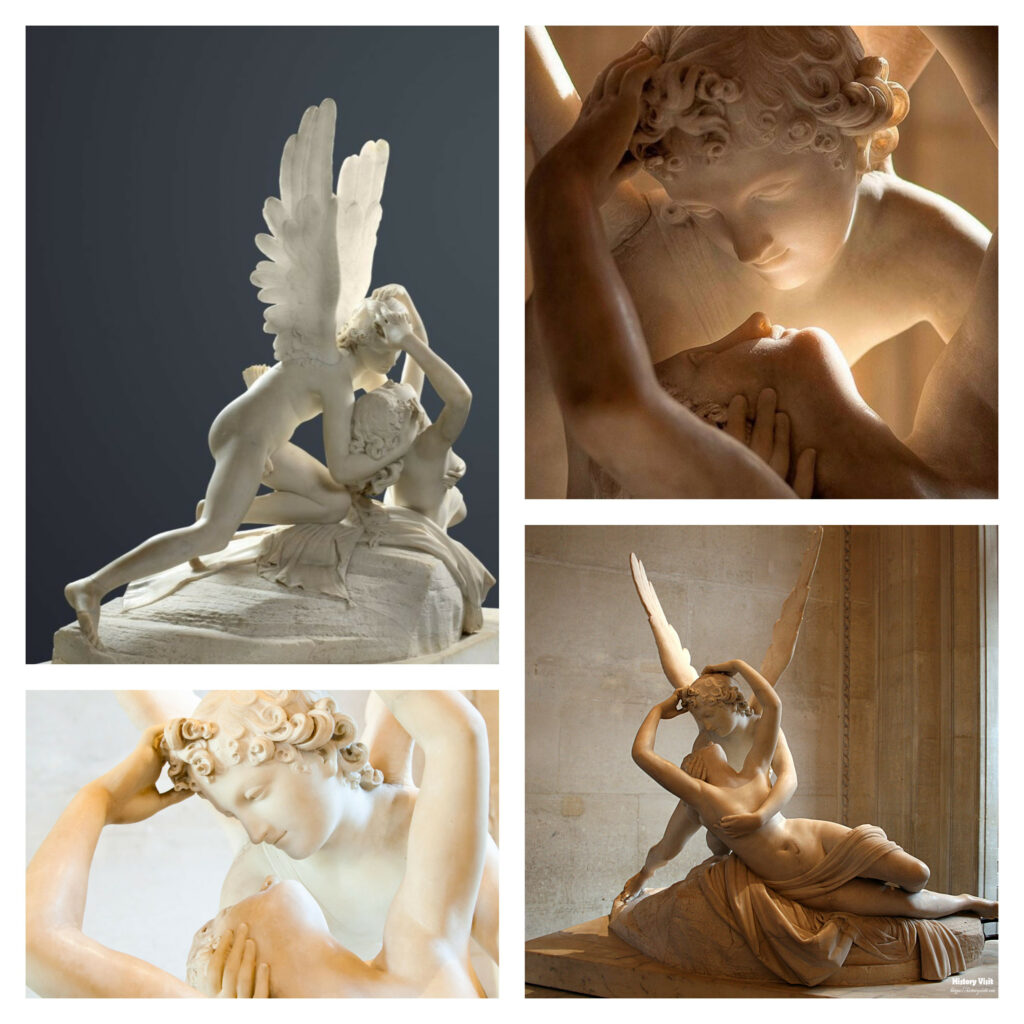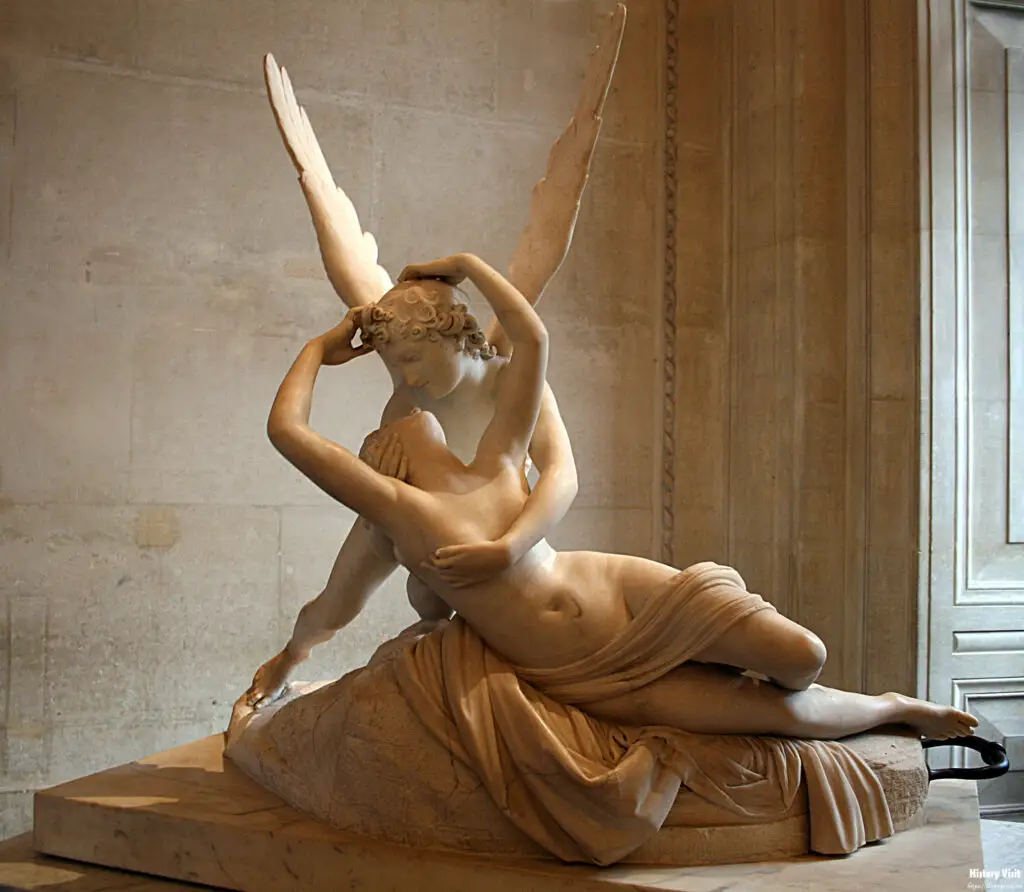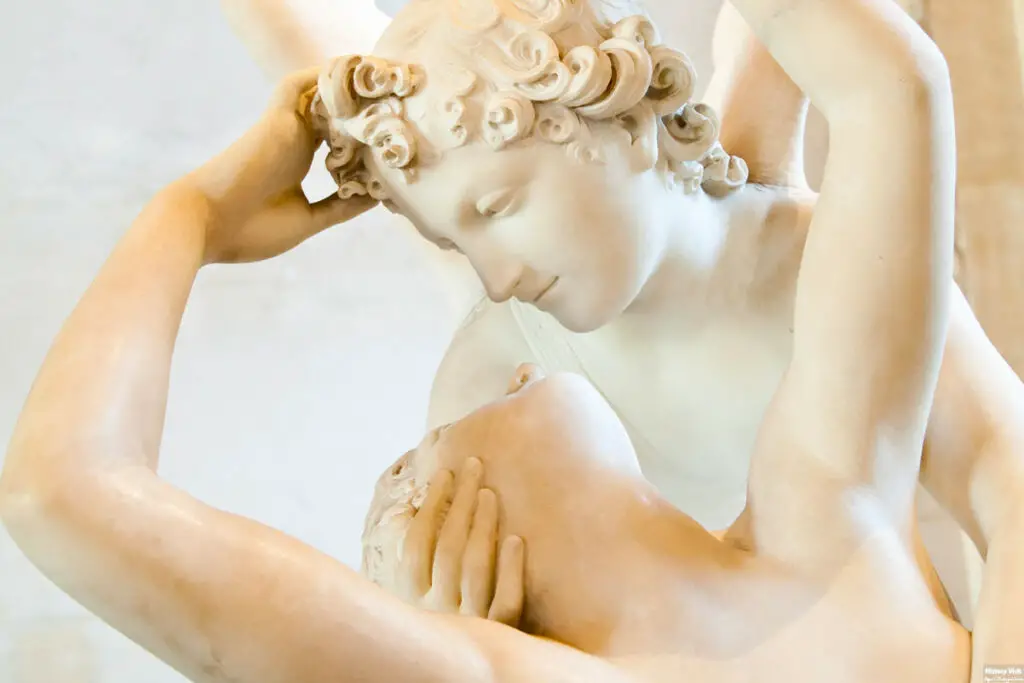Antonio Canova: The Heartbreaking Beauty of Psyche Revived

Introduction
Antonio Canova was a renowned Italian sculptor known for his exquisite marble sculptures. One of his most celebrated works is “Psyche Revived by Cupid’s Kiss.” This masterpiece captures a tender moment from Greek mythology. It showcases Canova’s exceptional talent and attention to detail.
The sculpture depicts the mythological lovers, Psyche and Cupid. Canova’s work is admired for its emotional depth and intricate craftsmanship. This article delves into the details of this iconic sculpture. We will explore its background, artistic elements, and impact on art history.
Understanding the significance of this sculpture requires an appreciation of Antonio Canova’s contributions to art. We will also discuss the broader context of neoclassical sculpture. Join us as we uncover the story behind “Psyche Revived by Cupid’s Kiss.”
Background of the Sculpture
The Myth of Psyche and Cupid

The myth of Psyche and Cupid originates from Greek mythology. Psyche, a mortal woman, was known for her extraordinary beauty. She attracted the envy of the goddess Venus. Venus sent her son, Cupid, to make Psyche fall in love with a monster. However, Cupid fell in love with her instead.
Their love story is filled with trials and tribulations. Psyche endured numerous challenges to be with Cupid. The climax of the myth is Cupid reviving Psyche with a kiss. This moment symbolizes the triumph of love over adversity. It is this moment that Antonio Canova chose to immortalize in marble.
Inspiration of Antonio Canova
Antonio Canova was deeply inspired by classical mythology. He sought to capture the beauty and emotion of these ancient tales. Canova’s work reflects his admiration for classical art. He was particularly drawn to the themes of love and beauty.
“Psyche Revived by Cupid’s Kiss” was created between 1787 and 1793. It was commissioned by Colonel John Campbell, an art collector. Canova’s aim was to create a sculpture that embodied grace and tenderness. He achieved this through meticulous attention to detail and expert craftsmanship.
Creation Process
Canova’s creation process was painstaking and detailed. He began with preparatory sketches and clay models. These preliminary steps allowed him to perfect the composition. Once satisfied, Canova moved on to carving the marble.
The marble used for the sculpture was of the highest quality. Canova’s skill in handling the material is evident in the delicate features and flowing drapery. The process required patience and precision. Canova’s dedication resulted in a sculpture that appears almost lifelike.
Artistic Elements

Composition and Design
The composition of “Psyche Revived by Cupid’s Kiss” is a masterclass in balance and harmony. The figures of Psyche and Cupid are intertwined in a graceful pose. Their bodies form a flowing, circular motion. This creates a sense of unity and movement.
Canova’s design emphasizes the emotional connection between the two characters. Psyche’s body is gently supported by Cupid. Their gazes are locked, conveying a deep sense of affection. The positioning of the wings adds to the overall elegance of the composition.
Detail and Realism
Antonio Canova was renowned for his attention to detail. This sculpture is no exception. The intricate carving of the hair, feathers, and fabric showcases his skill. Each element is rendered with remarkable precision.
The realism of the sculpture is striking. The softness of the skin, the delicacy of the fingers, and the folds of the drapery are meticulously crafted. Canova’s ability to transform marble into lifelike forms is a testament to his genius.
Emotional Expression
The emotional expression in “Psyche Revived by Cupid’s Kiss” is profound. Canova captures the tenderness and vulnerability of the moment. Psyche’s face reflects a mixture of relief and joy. Cupid’s expression is one of gentle care and love.
The interaction between the characters is deeply moving. Canova’s use of body language and facial expressions conveys a powerful narrative. The sculpture evokes a strong emotional response from viewers. It is a celebration of love and devotion.
Impact on Art History

Neoclassical Movement
Antonio Canova was a leading figure in the neoclassical movement. This artistic style drew inspiration from classical antiquity. Neoclassical artists sought to revive the ideals of beauty and harmony found in ancient Greek and Roman art.
“Psyche Revived by Cupid’s Kiss” embodies the principles of neoclassicism. Canova’s work is characterized by its elegance, simplicity, and restraint. The sculpture reflects a return to classical ideals. It played a significant role in shaping the direction of neoclassical art.
Influence on Contemporary Artists From Antonio Canova
Canova’s work has had a lasting impact on contemporary artists. His mastery of form and technique continues to inspire sculptors. Many artists have studied Canova’s sculptures to understand his approach to composition and detail.
The emotional depth and realism of Canova’s work set a high standard. Artists strive to achieve similar levels of expression and craftsmanship. Canova’s influence is evident in the works of many modern sculptors. His legacy endures through the continued admiration of his art.
Preservation and Exhibitions
“Psyche Revived by Cupid’s Kiss” is preserved in several museums. One of the most famous versions is housed in the Louvre Museum in Paris. Another version is located in the Hermitage Museum in Saint Petersburg.
The sculpture is frequently featured in exhibitions. These exhibitions celebrate Canova’s contributions to art. They provide an opportunity for new audiences to experience his work. The preservation and display of Canova’s sculptures ensure that his legacy lives on.
Major Works of Antonio Canova
Perseus with the Head of Medusa
“Perseus with the Head of Medusa” is another renowned sculpture by Antonio Canova. Created between 1804 and 1806, it depicts the Greek hero Perseus holding the severed head of Medusa. The sculpture showcases Canova’s ability to capture dynamic movement and intense emotion.
The figure of Perseus is poised and triumphant. His expression is one of determination and pride. The intricate details of Medusa’s head, with its serpentine hair, demonstrate Canova’s skill. This work is celebrated for its dramatic composition and technical brilliance.
The Three Graces
“The Three Graces” is a masterpiece of neoclassical sculpture. Created between 1814 and 1817, it represents the three daughters of Zeus: Euphrosyne, Aglaea, and Thalia. They are depicted standing together in a harmonious, intertwined pose.
Canova’s rendering of the Graces is graceful and delicate. Their bodies are depicted with soft, flowing lines. The sculpture exudes a sense of elegance and beauty. It is a quintessential example of Canova’s ability to capture the essence of classical ideals.
HUMANITY AGAINST EVIL
“HUMANITY AGAINST EVIL” is a powerful work by Antonio Canova. It depicts a dramatic struggle between good and evil. The composition is dynamic and intense, showcasing Canova’s mastery of form and emotion.
The figures are engaged in a fierce battle. Their expressions and poses convey a sense of urgency and determination. Canova’s attention to detail is evident in the rendering of muscles and drapery. This sculpture is a testament to Canova’s ability to convey complex themes through his art.
Conclusion

Antonio Canova’s “Psyche Revived by Cupid’s Kiss” is a masterpiece of neoclassical sculpture. It captures a tender moment from Greek mythology with exquisite detail and emotional depth. Canova’s dedication to his craft is evident in every aspect of the sculpture.
The background of the sculpture provides insight into Canova’s inspiration and creation process. The artistic elements highlight his skill in composition, detail, and emotional expression. The impact of this work on art history is significant, influencing both the neoclassical movement and contemporary artists.
Canova’s major works, including “Perseus with the Head of Medusa,” “The Three Graces,” and “HUMANITY AGAINST EVIL,” further showcase his talent. These sculptures continue to inspire and captivate audiences around the world.



Really beautiful